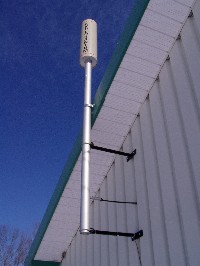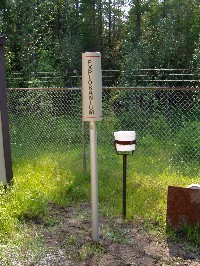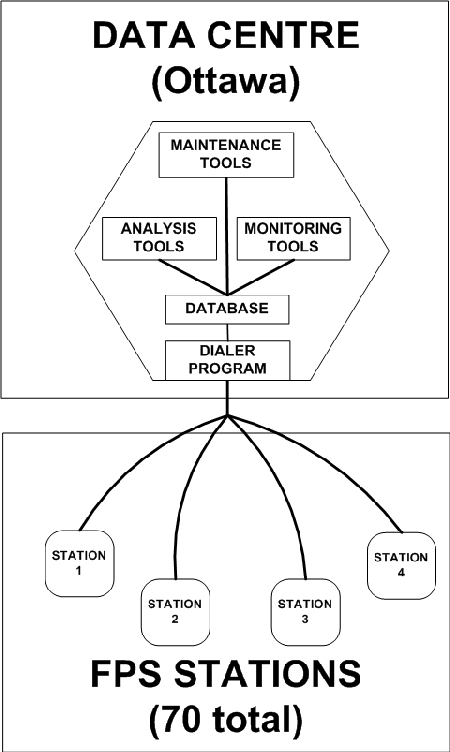Technical Details of the Fixed Point Surveillance Network
The Fixed Point Surveillance (FPS) network is designed to identify radioactive materials released into the air due to human activities (commonly referred to as anthropogenic or artificial radiation) and distinguish them from natural background radiation. A more detailed discussion on natural and artificial radiation can be found at Health Canada's Environmental Radiation page.
The detector used at the FPS stations is a GR150 model Sodium Iodide (NaI) Detector from Science Applications International Corporation (SAIC Exploranium). These detectors are highly sensitive and robust enough for operation within the typical extremes of the Canadian climate with minimal intervention. At some stations the detector is installed on a building wall or roof, as shown in Figure 1, while at other stations the detector is installed near ground level, as shown in Figure 2.


In either case the detector is connected to an interface box located in a secure and sheltered environment, typically inside a nearby building. This interface box provides electrical power to the detector and a telephone line for communication between the detector's modem and the data centre in Ottawa. A typical installation looks like that shown in Figure 3.

Figure 3: Typical setup of a ground-installed GR150 detector - Text Description
This diagram shows a typical setup of a ground-installed GR150 detector. The detector is connected to an interface box located in a secure and sheltered environment; a building in this case. This interface box provides electrical power to the detector and a telephone line for communication between the detector's modem and the Data Centre in Ottawa.
The detector assembly, shown in the Figure 3, contains the NaI detector itself as well as some hardware for power management, a modem for communication and an on-board computer for preliminary processing of the data collected by the detector. This data is organized into 15 minute intervals and stored until it can be retrieved by the data centre in Ottawa. In general, the detectors are able to store up to 10 days worth of data if necessary but usually the data is downloaded to the data centre daily. During an emergency situation the data would be accessed every 15 minutes.
The relationship between the data centre and the network of stations is shown in Figure 4.

Figure 4: The relationship between the FPS stations and the data centre in Ottawa - Text Description
This diagram shows the relationship between the FPS stations and the Data Centre in Ottawa. The diagram illustrates the flow of data from the detectors to the database, which is shown to be located at the Data Centre in Ottawa. The raw data from the detectors is downloaded by a dialer program and automatically processed into a database for storage. Software tools, identified as "Monitoring Tools", "Maintenance Tools" and "Analysis Tools" are then connected to the database.
The raw data is downloaded by the dialer program and automatically processed into a database for storage.
Other software tools are then used to:
- monitor that the data is being transmitted successfully and on-time to the data centre
- analyze the data and ensure proper calibration of all data
- keep track of station statistics, maintenance history, problem tracking and other administrative items.
Page details
- Date modified: